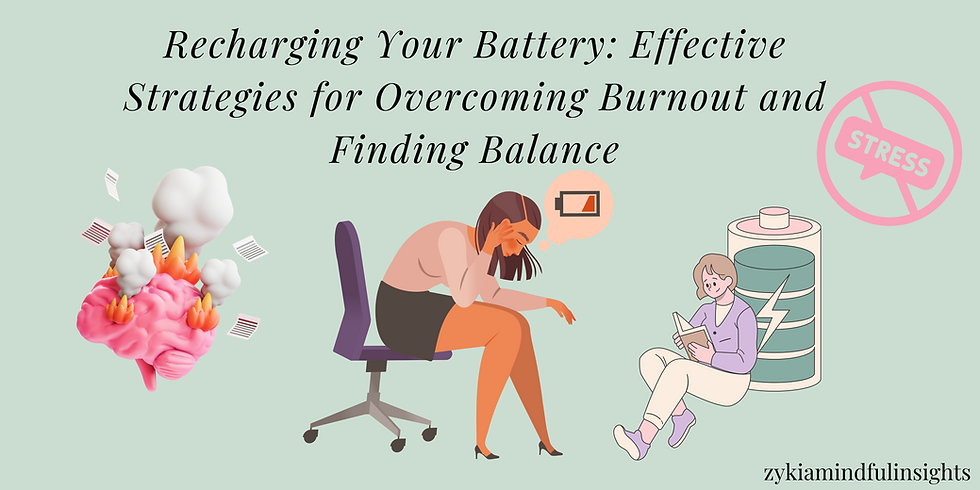Coping with Anxiety in Children and Teens
- Zykia Hannah

- Feb 21, 2024
- 6 min read
Anxiety can be a common experience for children and teenagers, but it's important to recognize the difference between typical worries and persistent anxiety. By distinguishing between the two, you can support your child in finding effective ways to cope with their symptoms.
Dealing with anxiety in children and teens requires a combination of supportive approaches, including:
Validation: Recognize and validate their feelings. Let them know that it's okay to feel anxious and that many others experience similar emotions.
Communication: Encourage open dialogue and provide a safe space for them to express their thoughts and concerns without judgement.
Education: Help them understand what anxiety is and how it affects the body and mind. Provide age-appropriate resources and information.
Relaxation Techniques: Teach them relaxation techniques, such as deep breathing, mindfulness, progressive muscle relaxation, and visualization.
Healthy Lifestyle: Encourage a balanced diet, regular exercise, sufficient sleep, and limited screen time, as these factors can influence mental well-being.
Building Resilience: Help them develop coping skills, problem-solving strategies, and positive self-talk to handle stressful situations.
Professional Support: If the anxiety is severe or persistent, consider seeking professional help from a therapist or counselor.
Manage Media Exposure: Be mindful of the media they consume, as negative news or social media can contribute to anxiety.
Remember, each child is unique, so it's essential to tailor your approach to their individual needs and personality.

Understanding Anxiety in Children and Teens
Anxiety in children and teens often presents differently from adults. For younger children, it might manifest as clinginess, separation anxiety, or physical complaints like stomaches and headaches. Older children and teenagers may be more adept at verbalizing their worries, but they can also experience more self-consciousness, social anxiety, and school-related stress. Recognizing these differences can help adults provide more targeted support and intervention.
Moreover, anxiety in young individuals can be triggered by various factors, including school pressures, family dynamics, and even a predisposition to anxiety due to genetics. It's essential to identify and address these triggers. Additionally, anxiety can co-occur with other mental health conditions such as depression or ADHD, making diagnosis and treatment more complex. Tailoring intervention strategies to the individual and understanding their development stage are critical for effective support.
Symptoms of Anxiety in Children vs. Teens
Anxiety symptoms in children and adolescents are diverse and can be challenging to recognize. Some common signs of anxiety disorders in young individuals include irritability, excessive worrying, shyness, sleep disturbances, and physical symptoms such as headaches or digestive problems. It's essential to pay attention to these signs and seek professional guidance if they persist or significantly impact the child's daily life. Here's a comparison of the symptoms in both age groups:
Symptoms in Children (Ages 6 to 12):
Physical complaints: stomachaches, headaches, fatigue
Behavioral changes: increased clinginess, difficulty concentrating, avoidance of school or social situations
Separation anxiety: fear of being apart from parents or caregivers
School-related stress: worrying excessively about grades, friends, or teachers
Nightmares or trouble sleeping
Negative self-talk or self-blame
Physical signs of anxiety, such as sweating or trembling.
Symptoms in Teens (Ages 13 to 18):
Social anxiety: fear of judgement, avoidance of social situations
Perfectionism: striving for high standards, fear of failure
School-related stress: excessive worry about grades, exams, or college
Difficulty with transitions or changes
Peer pressure: concern about fitting in, being liked, or being accepted
Self-consciousness: worry about physical appearance, behavior in front of others
Depressive symptoms: feeling hopeless, loss of interest in activities
It's important to note that these symptoms can vary widely among individuals, and not every child or teenager will exhibit all of these signs. It you're concerned about a child or teen's anxiety, it's best to seek professional guidance for a comprehensive assessment and appropriate support.
What is the 3-3-3 Rule?
The 3-3-3 rule is a grounding technique often used for children experiencing anxiety. It involves three steps, each repeated three times, and focuses on utilizing the five senses to help calm the child down. The process typically looks like this:
First Step (3 Times): Have the child look around and identify three things they can see. Encourage them to describe each item in detail, such as its color, shape, or texture.
Second Step (3 Times): Have the child listen and identify three things they can hear. it might be the sound of a clock ticking, the hum of a fan, or birds chirping outside.
Third Step (3 Times): Have the child touch and identify three things they can physically touch. This could be a soft blanket, a smooth table surface, or the ground beneath their feet.
The 3-3-3 rule helps shift the child's focus away from anxious thoughts and into the present moment, engaging their senses and grounding them in the immediate environment. It can be a simple yet effective tool for managing anxiety in children.
Causes of Anxiety in Kids
Children can become anxious due to a variety of reasons. Anxiety disorders, in particular, are often a result of both environmental and biological influences. These disorders can be genetic, as anxiety often runs in families and is more prevalent among girls than boys. These are several types of anxiety disorders, such as generalized anxiety disorder (GAD), obsessive-compulsive disorder (OCD), panic disorder, post-traumatic stress disorder (PTSD), social anxiety disorder, and various specific phobias. Additionally, some children experience separation anxiety, which involves fear and distress when away from home.
Anxiety is not a one-size-fits-all condition, especially in children and adolescents. Many young individuals can experience more than one type of anxiety simultaneously. Among the numerous types, three of the most prevalent in children are separation anxiety, social anxiety, and generalized anxiety.
The beginning of and anxiety disorder is frequently sparked by challenging situations, such as sudden shifts in their environment, academic struggles, being given excessive responsibility for their age, family turmoil, or traumatic events like bullying or abuse.
Additional Tips for Helping a Teen
The strategies outlined earlier can prove effective for managing anxiety in both children and teenagers. However, since adolescents and teens typically posses a certain level of understanding about anxiety and anxiety disorders, there are additional tactics that might prove beneficial.
Talk to your Teen about Anxiety
Remind your teenager that anxiety can sometimes act as a protective instinct. It heightens our awareness of potential hazards and helps us stay safe. That uneasy sensation in the stomach, for example, could be a sign of a looming danger. Since being attuned to these alerts helps us sidestep risky circumstances, experiencing anxiety can serve a beneficial purpose. Additionally, you can help your teenager feel less apprehensive about their anxiety by discussing actionable steps they can take to improve a situation in the future.
Keep an open dialog with your teen.
Stay connected with teenagers can prove challenging, and there might be moments of discomfort. As teens grow more self-reliant, they may not always seek counsel from their parents. employing a supportive and empathetic communication approach will nurture trust and encourage them to open up about their emotions.
Fostering ongoing communication with teenagers is crucial. By asking about their day, even if they offer limited details, you're showing genuine care and interest. A few supportive remarks can make a significant impact. Express pride in their achievements and commend their growth. When they express concern or anxiety about a specific situation, it's an opportunity for deeper dialogue. Acknowledge their feelings by saying "I understand this is challenging" or "that sounds really tough."
How to Help a Child having a Panic Attack
Panic attacks can be profoundly unsettling, both for children who experience them and for parents who witness them. While they typically arise during adolescence, panic attacks can manifest in childhood, too. These episodes can endure for up to 10 to 15 minutes, and present various symptoms such as a rapid heartbeat, sweating, chest pain, dizziness, and a sensation of choking. You can help your child by teaching them about panic attacks, providing an understanding of their triggers, and reassuring them that although the physical sensations can be alarming, they are not harmful or life-threatening.
You can support your child or teenager during a panic attack by being a calming presence and showing understanding. Reassure them that the episode will pass in a few minutes, and redirect their attention to something positive. Activities such as light exercise, playing games, watching tv, or engaging in breathing and relaxation exercises-things that enjoy-can be helpful.
Children might attempt to steer clear of certain scenarios-like attending school or venturing out-due to their anxiety about having a panic attack. Nevertheless, encouraging your child to maintain their regular school and social routines can prevent the fear of a panic attack from disrupting their overall development.
In conclusion, understanding and managing anxiety in children and adolescents is essential for their well-being and overall development. Anxiety can arise from various factors, including genetics, environmental influences, brain chemistry, temperament, and learned behavior. It can manifest in different ways, such as physical symptoms, behavioral changes, cognitive aspects.
By recognizing the signs and triggers of anxiety, providing a supportive environment, and teaching coping strategies, we can help children and teens navigate their emotions more effectively. Open communication, empathetic listening, and validation of their experiences are crucial. Encouraging healthy lifestyles, fostering resilience, and seeking professional support when needed can contribute to long-term mental wellness. Remember, each child is unique, so it's vital to tailor our approaches to their individual needs and personalities. Together, we can provide the necessary support and intervention to help children and teens thrive.
🤍Quote of the day:
"A simple smile. That's the start of opening your heart and being compassionate to others." - Dalai Lama




Comments